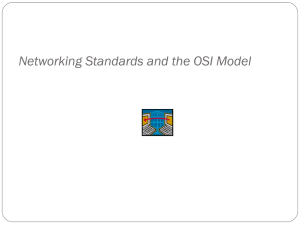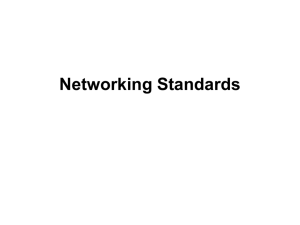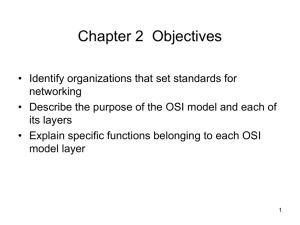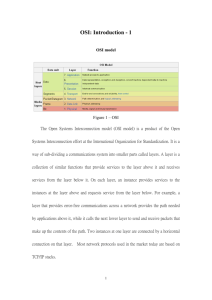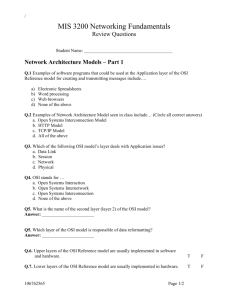Chapter 2 - Wright State University
advertisement
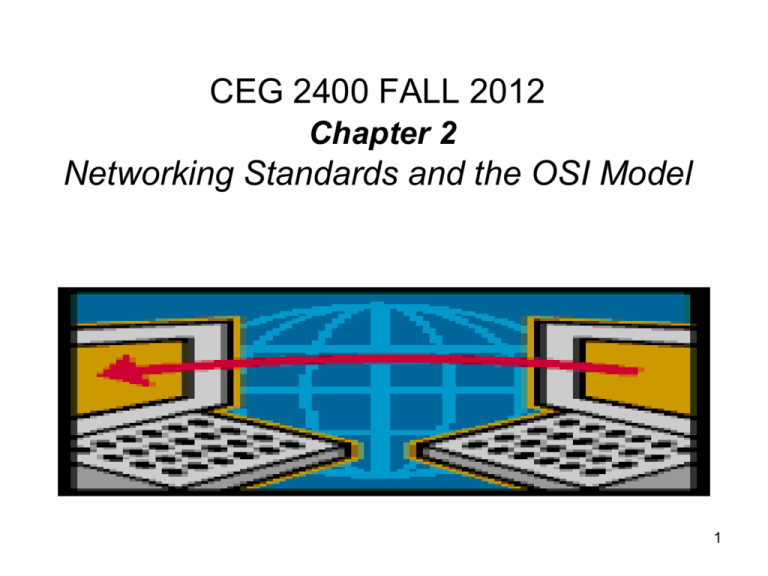
CEG 2400 FALL 2012 Chapter 2 Networking Standards and the OSI Model 1 STANDARDS • Why Have Networking Standards? Networking Standards • What is a Standard – Documented agreement containing technical specifications – Stipulates design or performance of particular product or service – Where would we be without standards? • Standards are essential in the networking world – Wide variety of hardware and software – Ensure network design compatibility • Standards define minimum acceptable performance – Not ideal performance 3 Networking Standards Organizations • Without organizations there would be no standards • Many different organizations oversee computer industry standards • Organizations responsibilities may overlap – Example: ANSI and IEEE set wireless standards – ANSI standards apply to type of NIC – IEEE standards involve communication protocols 4 ANSI • ANSI (American National Standards Institute) – Determines standards for electronics industry and other fields – Represents US in setting international standards • Requests voluntarily compliance with standards • Obtaining ANSI approval requires rigorous testing • ANSI standards documents available online – www.ansi.org 5 EIA and TIA • EIA (Electronic Industries Alliance) – Trade organization • Sets standards for its members – Lobbies for favorable computer and electronics industries legislation and helps write ANSI standards • TIA (Telecommunications Industry Association) – Focus of TIA • Standards for information technology, wireless, satellite, fiber optics, and telephone equipment • TIA/EIA 568-B Series – Guidelines for installing network cable in commercial buildings 6 IEEE • IEEE (Institute of Electrical and Electronics Engineers) • Goal of IEEE – Promote development and education in electrical engineering and computer science fields • Maintains a standards board • IEEE technical papers and standards are highly respected (www.ieee.org) 7 ISO • ISO (International Organization for Standardization) – Headquartered in Geneva, Switzerland – Collection of standards organizations • Represents 162 countries • Goal of ISO – Establish international technological standards to facilitate global information exchange and barrier free trade • Widespread authority • Not limited to just communications (ex. banking) 8 ITU • ITU (International Telecommunication Union) – Specialized United Nations agency – Regulates international telecommunications – Provides developing countries with technical expertise and equipment – Members from 193 countries • Focus of ITU – Global telecommunications issues – Worldwide Internet services implementation 9 ISOC • ISOC (Internet Society) – Founded in 1992 – Establishes technical Internet standards • Current ISOC concerns – – – – – Rapid Internet growth Keeping Internet accessible Information security Stable Internet addressing services Open standards 10 ISOC (cont’d.) • ISOC oversees groups with specific missions – IAB (Internet Architecture Board) • Oversees Internet’s design and management – IETF (Internet Engineering Task Force) • Sets Internet system communication standards – Particularly protocol operation and interaction • Anyone may submit standard proposal • Elaborate review, testing, and approval processes 11 IANA and ICANN • IANA (Internet Assigned Numbers Authority) and ICANN (Internet Corporation for Assigned Names and Numbers) – www.Iana.org and www.icann.org • IP (Internet Protocol) address – Address identifying computers in TCP/IP based (Internet) networks – Reliance on centralized management authorities 12 IANA and ICANN (cont’d.) • IP address management history – Initially: IANA (Internet Assigned Numbers Authority) – 1997:Three RIRs, now 5(Regional Internet Registries) • ARIN Canada, many Caribbean and North Atlantic islands, and the United States • APNIC Portions of Asia, portions of Oceania • LACNIC Latin America, portions of the Caribbean • RIPE NCC Europe, the Middle East, Central Asia • AFRINIC Africa, portions of the Indian Ocean 13 IANA and ICANN (cont’d.) • IP address management history (cont’d.) – Late 1990s: ICANN (Internet Corporation for Assigned Names and Numbers) took over • Private nonprofit corporation • Remains responsible for IP addressing and domain name management • Helps co-ordinate how IP addresses are supplied • ICANN is also the central repository for IP addresses • IANA performs system administration 14 IANA and ICANN (cont’d.) • The way it works: – Users and business obtain IP addresses from ISP (Internet service provider) who get it from regional internet registries (RIR) who ultimately get it from ICANN – Regional Internet Registry (RIR) 15 The OSI Model • What is the OSI Model? The OSI Model • OSI (Open Systems Interconnection Model) • Model for understanding and developing network computer-to-computer communications • Developed by ISO in the 1980s • Divides network communications into seven layers – Physical, Data Link, Network, Transport, Session, Presentation, Application 17 The OSI Model (cont’d.) • Protocol interaction – Layer directly above and below • Application layer protocols – Interact with software (ex. MS word) • Physical layer protocols – Act on cables and connectors (UTP cable) 18 The OSI Model (cont’d.) • Theoretical representation describing network communication between two nodes • Hardware and software independent • Every network communication process is represented • PDUs (protocol data units) – Discrete amount of data – Application layer function – Flow through layers 6, 5, 4, 3, 2, and 1 • Generalized model and sometimes imperfect 19 Flow of data through the OSI model 20 Application Layer • Top (seventh) OSI model layer • Does not include software applications • Protocol functions – Facilitates communication between software applications (ex. MS word) and lower-layer network services – Network interprets application request – Application interprets data sent from network 21 Application Layer (cont’d.) • Software applications negotiate with application layer protocols – Formatting, procedural, security, synchronization, and other requirements • Example of Application layer protocol: HTTP, FTP 22 Application Programming Interface Application layer functions while retrieving a Web page 23 Presentation Layer • Protocol functions – Accept Application layer data – Formats data • Understandable to different applications and hosts • Examples: GIF, JPG, TIFF, MPEG, QuickTime • Servers as an interpreter (translator) – Encoding – interpret coding – character encoding • Presentation layer services manage data encryption and decryption – Example protocol: Secure Sockets Layer (SSL) 24 Presentation layer services while retrieving a secure Web page 25 Session Layer • Protocol functions – Coordinate and maintain communications between two network nodes • Session – Connection for ongoing data exchange between two parties • Connection between two devices • EX: between remote client and access server • EX: between Web browser client and Web server 26 Session Layer (cont’d.) • Functions – Establishing and keeping alive communications link • For session duration – Keeping communications secure – Synchronizing dialogue between two nodes – Determining if communications ended • Determining where to restart transmission – Terminating communications – Set terms of communication – Identify session participants 27 Session layer protocols managing voice communications 28 Transport Layer • Protocol functions – Accept data from Session layer – Manage end-to-end data delivery, correctly in order – Handle flow control • Connection-oriented protocols – Establish connection before transmitting data – Example: TCP three-way handshake • SYN (synchronization) packet • SYN-ACK (synchronization-acknowledgment) • ACK 29 TCP three-way handshake 30 Transport Layer (cont’d.) • Checksum – Unique character string allowing receiving node to determine if arriving data matches sent data • Connectionless protocols – Do not establish connection with another node before transmitting data – Do not check for data integrity (errors) – Faster than connection-oriented protocols (no overhead) – Useful when data must be transferred quickly 31 Transport Layer (cont’d.) • Segmentation – Breaking large data units received from Session layer into multiple smaller units called segments – Increases data transmission efficiency • MTU (maximum transmission unit) – Largest data unit network will carry – Ethernet default: 1500 bytes – Discovery routine used to determine MTU 32 Transport Layer (cont’d.) • Reassembly – Recombining the segmented data units • Sequencing – Identifying segments belonging to the same group of subdivided data – Specifies where data begins 33 Segmentation and reassembly 34 A TCP segment 35 Network Layer • Protocol functions – Translate network addresses into physical counterparts – Decide how to route data from sender to receiver • Addressing – System for assigning unique identification numbers to network devices • Types of addresses – Network addresses (logical or virtual) – Physical addresses 36 Network Layer (cont’d.) • Network address example: 10.34.99.12 • Physical address example: 0060973E97F3 • Factors used to determine routing path – – – – Delivery priority Network congestion Quality of service Cost of alternative routes • Routers belong in the network layer 37 Network Layer (cont’d.) • Common Network layer protocol – IP (Internet Protocol) • Fragmentation – Subdividing Transport layer segments – Performed at the Network layer • Packet formation is here – Transport layer segment appended with logical addressing information 38 An IP packet 39 Data Link Layer • Function of protocols – Divide data received into distinct frames for transmission in Physical layer • Frame – Structured package for moving data • Includes raw data (payload), sender’s and receiver’s network addresses, error checking and control information 40 Data Link Layer (cont’d.) • Possible communication mishap – Not all information received or correctly received • Frames are not the same • Corrected by error checking – Frame check sequence – CRC (cyclic redundancy check) • Possible glut of communication requests – Data Link layer controls flow of information • Allows NIC to process data without error 41 Data Link Layer (cont’d.) • Two Data Link layer sublayers – LLC (Logical Link Control) sublayer – MAC (Media Access Control) sublayer • MAC sublayer – Manages access to the physical medium – Appends physical address of destination computer onto data frame 42 The Data Link layer and its sublayers 43 Data Link Layer (cont’d.) • Physical address (sometimes called MAC address) – Fixed number associated with each device’s network interface • MAC address components – Block ID • Six-character sequence unique to each vendor – Device ID • Six-character number added at vendor’s factory • MAC addresses frequently depicted in hexadecimal format (0067973E97F3) • EUI-64 – Block ID 6 characters, Device ID extended to ten characters 44 Manufacture lookup site: http://www.wireshark.org/tools/oui-lookup.html A NIC’s physical address or can be found by using ipconfig /all 45 Physical Layer • Functions of protocols – Accept frames from Data Link layer – Generate signals as changes in voltage at the NIC • Types of medium – Copper transmission medium • Signals issued as voltage – Fiber-optic cable transmission medium • Signals issued as light pulses – Wireless transmission medium • Signals issued as electromagnetic waves 46 Physical Layer (cont’d.) • Physical layer protocols’ responsibilities when receiving data – – – – – Detect and accept signals Pass on to Data Link layer Set data transmission rate Monitor data error rates No error checking • Devices operating at Physical layer – Hubs and repeaters 47 Applying the OSI Model Functions of the OSI layers 48 Communication Between Two Systems • Data transformation (as seen through the 7 layers) – Original software application data differs from application layer to NIC data • Information added at each layer • PDUs – Generated in Application layer • Segments – Generated in Transport layer – Unit of data resulting from subdividing larger PDU 49 Communication Between Two Systems • Packets – Generated in Network layer – Data with logical addressing information added to segments • Frames – Generated in Data Link layer – Composed of several smaller components or fields • Encapsulation – Occurs in Data Link layer – Process of adding a header and trailer component to make frame • Physical layer transmits frame over the network 50 51 Data transformation through the OSI model 52 OSI model vs TCP/IP model 53 Frame Specifications • Frames – Composed of several smaller components or fields • Frame characteristic dependencies – Network type where frames run – Standards frames must follow • Ethernet – Four different types of Ethernet frames – Most popular: IEEE 802.3 standard 54 Frame Specifications (cont’d.) • Token ring – Relies upon direct links between nodes and ring topology, Nearly obsolete – Defined by IEEE 802.5 standard • Ethernet frames and token ring frames differ – Will not interact with each other – Devices cannot support more than one frame type per physical interface or NIC 55 IEEE Networking Specifications • IEEE’s Project 802 – Effort to standardize physical and logical network elements • • • • • • Frame types and addressing Connectivity Networking media Error-checking algorithms Encryption Emerging technologies • 802.3: Ethernet • 802.11: Wireless 56 IEEE 802 standards 57 Summary • Standards and standard organizations help ensure interoperability between software and hardware from different manufacturers • ISO’s OSI (Open Systems Interconnection) model – Represents communication between two networked computers – Includes seven layers (Know) • IEEE’s Project 802 aims to standardize networking elements – Significant IEEE 802 standards include 802.3 (Ethernet) and 802.11 (wireless) 58 Misc • All People Seem To Need Data Processing – Application, Presentation, Session, Transport, Network, Data Link, Physical • http://www.wireshark.org/tools/oui-lookup.html • From Command Prompt: ipconfig /all • Find out who makes your NIC? 59 End of Chapter 2 Questions 60
